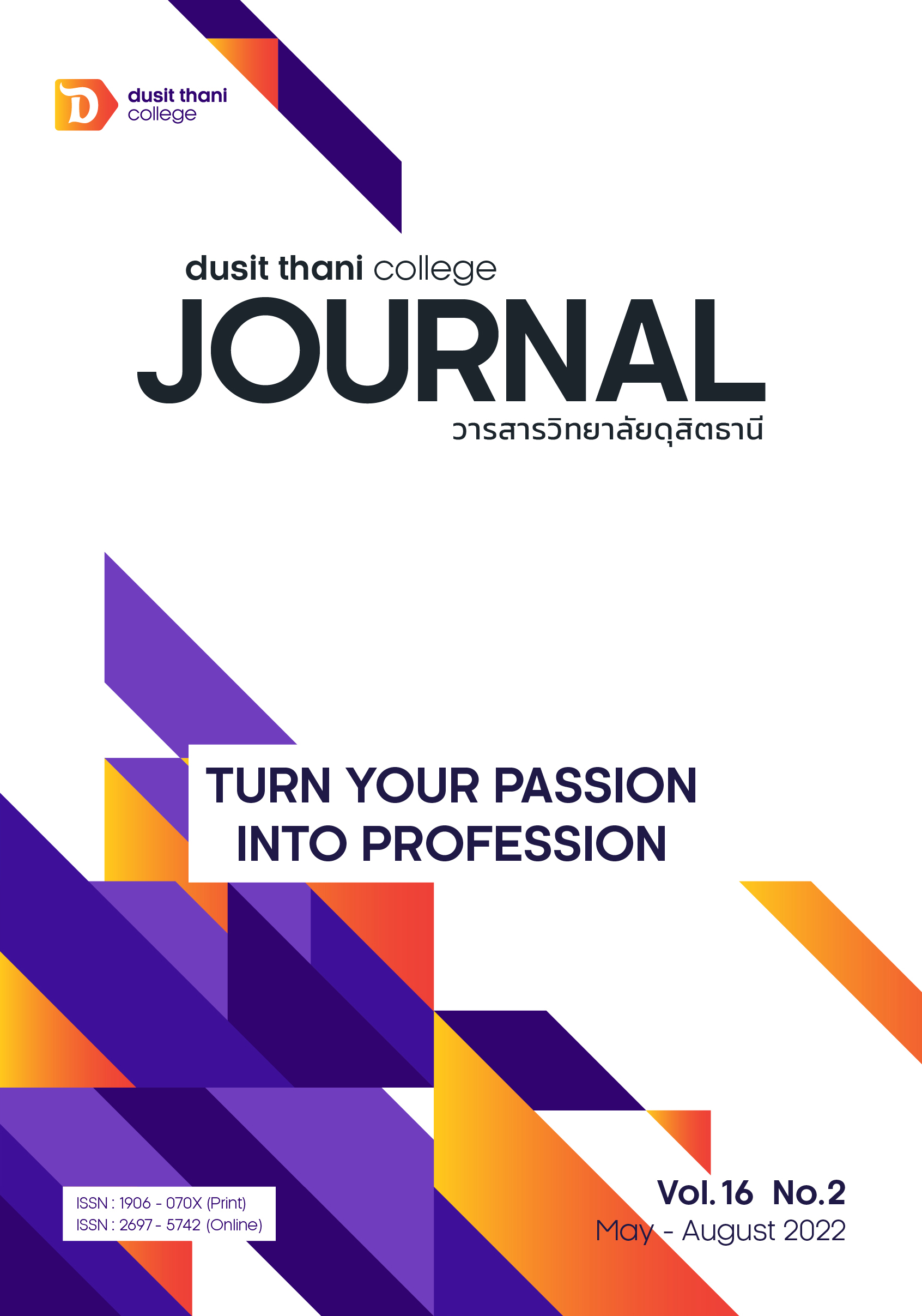พฤติกรรมของนักท่องเที่ยวชาวไทยที่เดินทางมาท่องเที่ยวในแหล่งท่องเที่ยวเชิงวัฒนธรรมในชุมชนของกรุงเทพมหานคร
Main Article Content
บทคัดย่อ
การศึกษาครั้งนี้มีวัตถุประสงค์ 1. เพื่อศึกษาพฤติกรรมของนักท่องเที่ยวชาวไทยที่เดินทางมาท่องเที่ยวในแหล่งท่องเที่ยวเชิงวัฒนธรรมในชุมชนของกรุงเทพมหานคร และ 2. เพื่อศึกษาความสัมพันธ์ระหว่างลักษณะทางประชากรศาสตร์กับพฤติกรรมของนักท่องเที่ยวชาวไทยที่เดินทางมาท่องเที่ยวในแหล่งท่องเที่ยวเชิงวัฒนธรรมในชุมชนของกรุงเทพมหานคร ซึ่งเป็นการวิจัยเชิงปริมาณ โดยทำการศึกษาจากกลุ่มตัวอย่าง จำนวน 400 คน วิเคราะห์ข้อมูลด้วยสถิติเชิงพรรณนา ได้แก่ ค่าความถี่ ค่าร้อยละ และสถิติการทดสอบไคสแควร์ กำหนดนัยสำคัญทางสถิติที่ระดับ 0.05
ผลการวิจัยพฤติกรรมของนักท่องเที่ยวชาวไทยที่มีต่อการเดินทางมาท่องเที่ยวในแหล่งท่องเที่ยวเชิงวัฒนธรรมในชุมชนของกรุงเทพมหานคร พบว่า ส่วนใหญ่เดินทางมากับครอบครัวและญาติ เดินทางมาท่องเที่ยวช่วงวันเสาร์-อาทิตย์ มีความถี่ในการเดินทางท่องเที่ยวน้อยกว่า 3 เดือน/ 1 ครั้ง ใช้พาหนะในการเดินทางมาท่องเที่ยวด้วยรถยนต์ส่วนตัว ใช้จ่ายในการเดินทางท่องเที่ยวเฉลี่ยต่ำกว่า 2,000 บาท
มีวัตถุประสงค์ของการเดินทางมาเพื่อพักผ่อนหย่อนใจ รองลงมาเพื่อชมโบราณสถานและโบราณวัตถุ และเพื่อใช้เวลาว่างกับบุคคลในครอบครัวเท่ากับเพื่อสัมผัสวิถีชีวิตชุมชน รู้จักแหล่งท่องเที่ยวในชุมชนจากสื่อเฟสบุ๊ค รองลงมาจากสื่อเว็บไซต์ และจากสื่อยูทูป รูปแบบการท่องเที่ยวเชิงวัฒนธรรมที่สนใจมากที่สุด คือ ชมแหล่งโบราณคดีและพิพิธภัณฑ์ รองลงมาสนใจรูปแบบการชมสถาปัตยกรรมเก่าแก่ดั้งเดิม และสนใจรูปแบบการซื้อสินค้า เครื่องแต่งกาย อาหารและของที่ระลึก
จากการทดสอบไคสแควร์ พบว่า เพศมีความสัมพันธ์กับค่าใช้จ่ายในการเดินทางท่องเที่ยว อายุมีความสัมพันธ์กับลักษณะการเดินทางมาท่องเที่ยว และพาหนะที่ใช้ในการเดินทางมาท่องเที่ยว สถานภาพมีความสัมพันธ์กับลักษณะการเดินทางมาท่องเที่ยว ช่วงเวลาในการเดินทางมาท่องเที่ยว พาหนะที่ใช้ในการเดินทางมาท่องเที่ยว และค่าใช้จ่ายในการเดินทางท่องเที่ยว ระดับการศึกษามีความสัมพันธ์กับพาหนะที่ใช้ในการเดินทางมาท่องเที่ยว อาชีพมีความสัมพันธ์กับลักษณะการเดินทางมาท่องเที่ยว ความถี่ในการเดินทางท่องเที่ยว พาหนะที่ใช้ในการเดินทางมาท่องเที่ยว และค่าใช้จ่ายในการเดินทางท่องเที่ยว และรายได้ต่อเดือนมีความสัมพันธ์กับลักษณะการเดินทางมาท่องเที่ยว ช่วงเวลาในการเดินทางมาท่องเที่ยว พาหนะที่ใช้ในการเดินทางมาท่องเที่ยว และค่าใช้จ่ายในการเดินทางท่องเที่ยวอย่างมีนัยสําคัญทางสถิติที่ระดับ 0.05
Article Details

อนุญาตภายใต้เงื่อนไข Creative Commons Attribution-NonCommercial-NoDerivatives 4.0 International License.
นโยบายการพิจารณากลั่นกรองบทความ
- บทความวิจัยและบทความวิชาการทุกเรื่องที่จะได้รับการตีพิมพ์ต้องผ่านการพิจารณากลั่นกรองโดยผู้ทรงคุณวุฒิ (Peer Review) ในสาขาที่เกี่ยวข้อง จำนวน 3 ท่าน/บทความ
- บทความ ข้อความ ภาพประกอบและตารางประกอบที่ลงตีพิมพ์ในวารสารเป็นความคิดเห็นส่วนตัวของผู้เขียน กองบรรณาธิการไม่จำเป็นต้องเห็นด้วยเสมอไป และไม่มีส่วนรับผิดชอบใด ๆ ถือเป็นความรับผิดชอบของผู้เขียนแต่เพียงผู้เดียว
- บทความที่จะได้รับการตีพิมพ์จะต้องไม่เคยตีพิมพ์ เผยแพร่ที่ใดมาก่อน และไม่อยู่ระหว่างการพิจารณาของวารสารฉบับอื่น หากตรวจสอบพบว่ามีการตีพิมพ์ซ้ำซ้อน ถือเป็นความรับผิดชอบของผู้เขียนแต่เพียงผู้เดียว
- บทความใดที่ผู้อ่านเห็นว่าได้มีการลอกเลียนหรือแอบอ้างโดยปราศจากการอ้างอิง หรือทำให้เข้าใจผิดว่าเป็นผลงานของผู้เขียน กรุณาแจ้งให้กองบรรณาธิการวารสารทราบจะเป็นพระคุณยิ่ง
เอกสารอ้างอิง
Goeldner, C. and Ritchie, J. R. B. (2006). Tourism: principles, practices, philosophies. (10th ed.). Hoboken : Wiley.
Kaeosuriya, R. (2006). 21st century tourism. Bangkok : Office of the National Economics and Social Development Council.
Kongsawat, J. (2007). The Promotion Study of Cultural Tourism at Uthong Suphanburi Province. Thesis of Master Degree. Silpakorn University.
Ministry of Tourism and Sports. (2019). Tourism Statistics 2019. Retrieved from https://www.mots.go.th/more_news_new.php?cid=521.
Mooncome, O. (2019). Guidelines for the Promotion of Cultural Tourism in the Special Economic Development Zone, Nakhon Phanom Province. Thesis of Doctor Degree. University of Phayao.
Nakabhop, C. (2018). The Model of Participartory Cultural Tourism Management of Koeichai Community, Chumsaeng District, Nakhonsawan Province. Valaya Alongkorn Review. 8(2), 71-80.
Phumiworramunee, S. (2018). Guidelines for the Promotion of Cultural Tourism Marketing in Nakhon Phanom Province. Thesis of Doctor Degree. University of Phayao.
Pinkaeo, K. (2012). Cultural Tourism Attractions. Retrieved from http://tourismdan1. blogspot.com.
Pratomkanjana, C. and Sangraksa, N. (2015). Guidelines for the Promotion of Cultural Tourism Participation of Community Bangluang, Banglen District, Nakhon Pathom. Academic Services Journal Prince of Songkla University. 26(1), 118-129.
Punroob et al. (2018). Marketing Development of Cultural Tourism in Nan Province. Prae-wa Kalasin Journal of Kalasin University. 5(3), 438 – 458.
Roirungrot, R. (2015). Tourist Behavior . Bangkok : Odeonstore.Strategy and Evaluation Department. (2019). Bangkok Annual Work Plan 2019. Retrieved from http://www.bangkok.go.th/upload/user/planing/BMAPLAN/BMAplan63.pdf.
Sukanthasirikul, K . (2013). The Quality Development of Cultural Tourism in North Eastern. Research. Nakornratchasima : Suranaree University of Teachnology.
Sukhanin, P. (2018). A Study of the Perception, the Attitude and the Behavior
Affecting the Decision to Cultural Tourism of Thai Tourists in the Bangkok Metropolis Area. Independent Studies. Bangkok University.
Techasitthanakun, K. (2006). The development of cultural tourism potential in the Mekong River, a case study of Wat Si UbonRattanaram, Mueang District, Ubon Ratchathani Province. Thesis of Master Degree. Ubon Ratchathani University.
Thangkratok, C. (2015). Guidelines to Promote the Cultural Tourism in Yaowarat District. Research. Nakhonpathom : Rajamangala University of Technology Rattanakosin.
Tourism Authority of Thailand. (2019). Summary of tourism promotion action plan for 2019. Retrieved from http://www.oic.go.th.
Yamane, T. (1973). Statistics : An Introductory Analysis. (3rd ed.). New York : Harper and Row Publications.
Yimsathan, N. (2010). Media Effects on Tourists in Decision Making for Chiang Mai Cultural Tour. Thesis of Master Degree. Maejo University.


